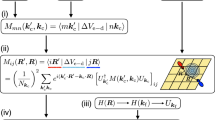Abstract
We examine the treatment of the hydrogenated Amorphous silicon (a-Si:H) dangling-bond defect used in the Analysis of microelectronic and Photonic Structures (AMPS) computer model and in other models of a-Si:H semiconductor devices. The dangling bond defect (D) is trivalent, with two correlated electronic levels in the gap. However, Modelers typically employ two uncorrelated bivalent levels to represent D; this introduces fictitious neutral dangling bond (D°) levels whenever D is charged. We find that the bivalent (AMPS) representation captures the important aspects of D physics and introduces only small errors into simulations. To reach this conclusion, we examine charge density and recombination and compare the trivalent D defect and its bivalent representation in both thermal equilibrium and non-equilibrium (illuminated) cases. The charge density is identical, implying that band bending computed by the simulation is accurate. We find errors in the recombination rate for the bivalent representation are normally less than or equal to σ0/σch, where σ° is the capture cross section of D0 and σch is the capture cross section of a charged state of D. Typically Modelers use σ0/σch of 1:10 to 1:100 yielding insignificant errors in the recombination rate with the uncorrelated bivalent representation.
Similar content being viewed by others
References
M. Hack and M. Shur, J. Appl. Phys. 58, 997 (1985)
F.A. Rubinelli, S.J. Fonash, J.K. Arch, 6th International PVSEC Proc., 851 (1992)
J.L. Gray, IEEE Trans. Electron Devices 36, 906 (1989).
M. Block, in Proceedings of the 15th International Conference on Amorphous Semiconductors, edited by S. R. Elliot, E. A. Davis, and J. Robertson Cambridge, UK, 1993), in press.
J. Hubin, A. V. Shah, and E. Sauvain, Phil. Mag. Lett. 66, 115 (1992).
H. Okamoto and Y. Hamakawa, Solid St. Comm. 24, 23 (1977).
J. G. Simmons and G. W. Taylor, Phys. Rev. B 4, 502 (1971).
Y. Bar-Yam and J.D. Joannopoulos, J. Non-Cryst. Solids 97&98, 467 (1987)
M.J. Powell and S.C. Deane, Phys. Rev. B 48, 10815 (1993).
Author information
Authors and Affiliations
Rights and permissions
About this article
Cite this article
Suntharalingam, V., Branz, H.M. On Modeling Trivalent Dangling Bonds with Bivalent Levels. MRS Online Proceedings Library 336, 153–158 (1994). https://doi.org/10.1557/PROC-336-153
Published:
Issue Date:
DOI: https://doi.org/10.1557/PROC-336-153




